Nouvelle Fabrique de Tavannes
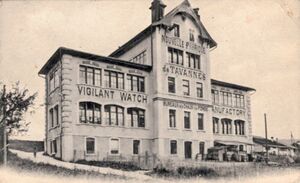
The "Nouvelle Fabrique" was the third major watch factory built in Tavannes. It was financed by the leading families in the town following a similar experiment a decade earlier that was growing quickly. This project was somewhat less successful, going bankrupt in 1930 and being absorbed into Ebauches SA. The factory lasted in various forms through 1962 and the original building later became a special workshop for psychiatric patients before being torn down around 1987.
Novelle Fabrique under Salomon Hirsch
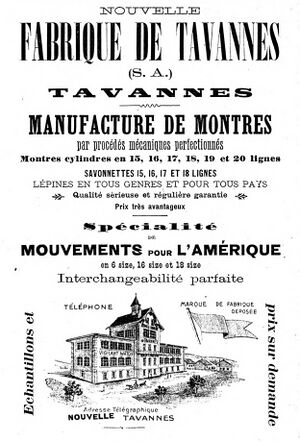
In 1891, the wealthy families of Tavannes decided to pull the town into watchmaking after the arrival of railroad transportation seriously dented the town's agricultural base. The result was the Tavannes Watch Co, which grew into one of the most successful watch and ebauche manufacturers in the world in just a decade thanks to the work of Henri-Fredéric Sandoz.
A decade later, the town decided to try again, building the "Nouvelle Fabrique" in 1900. The new building was located on Rue du Petit Bâle, just a block up the hill from the Grande-Rue downtown, unlike the original factory which was along the railroad tracks.
An open application process in May lead to the lease of the property to Salomon Hirsch of La Chaux-de-Fonds, with Reconvilier mayor and watchmaker Hippolyte Frêne also considered. Hirsch was the cousin (and brother-in-law) of Achille Hirsch, one of that town's most successful watch merchants. The Hirsch family saw the opportunity to use the new Tavannes factory to produce ebauches and watches for their Vigilant brand. Salomon Hirsch founded Nouvelle Fabrique de Tavannes SA, a limited corporation, on June 5, 1902, with share capital of 100,000 francs. Achille Hirsch and his son Félix were also board members. The firm quickly registered a logo featuring a pennant with the initials "N. F. T."
But the company, called Nouvelle Fabrique de Tavannes SA, faced issues from the outset, starting with open conflict with Sandoz' firm over the right to use the brand name "Tavannes". It also faced issues with the financiers, who demanded regular payment of their rents even as the company was just starting.
Still, Nouvelle Fabrique de Tavannes SA was able to offer a range of watches and movements, ranging from 15 to 20 lignes, using cylinder movements in savonette and lepine styles primarily for the American market. The factory was expanded in 1905 and in 1906 it was sold to Hirsch. It soon bore the "Vigilant Watch" brand used on the company's watches. By 1910, the population of Tavannes had expanded to over 2,500, which was attributed to the success of "the Hirsch factory" and the Tavannes Watch Co.
Salomon Hirsch died by 1908 so Georges Hirsch, already deputy director, took his place on the administrative council and board of directors along with Achille and Félix Hirsch. Hubert Hirsch took his place as deputy director of the factory but was removed the following year.
Louis Hutter and Louis Maeder
Louis Hutter joined management of the Nouvelle Fabrique in late 1910, at the same time Georges Hirsch was replaced on the board by Jules Hirsch of La Chaux-de-Fonds. Hutter, originally from Biezwil, lived in Courtelary, and he handed management of the company over to Louis Maeder of Mübleberg, who lived in Tavannes, on January 16 1914. Although the factory was still owned by the Hirsch family they were no longer actively involved in daily management. Hutter and Maeder would run the firm until 1930, though World War I and the post-war overproduction crisis.
The factory was expanded in 1917 with a lower L-shaped wing along Chemin de la Forge which still stands today.
After World War I, most high-volume ebauche producers faced issues and began "dumping" product on export markets. This exacerbated the issues facing the Swiss industry, and many companies failed throughout the 1920s. In fact, the Hirsch factory shut down entirely in 1921, as did the nearby Tavannes Watch Co, only reopening once the economic situation improved a year later.
Most product was shipped through La Chaux-de-Fonds and the hands of the Fils de Achille Hirsch & Co., a holding company which owned many watchmaking factories. Brands in 1930 included Vigilant, Minimax, Apt, Meted, Starter, and Invar, the French name for stainless steel. At this time the company focused on American, Latin America, and the Far East, including cylinder and anchor movements cased in steel, silver plate, and even a few platinum jewelry pieces.
But Hirsch's Nouvelle Fabrique was not as strong as the others, closing again in 1929 and facing bankruptcy the following year. After the death of Achille Hirsch that year Louis Hutter became the sole director of the failing firm as Louis Maeder departed. The company was declared bankrupt on January 3, 1930. It fell to Marc Germiquet, the town notary and lawyer, to straighten things out. Unable to reach an agreement to settle the company's debt at 50% with the Banque Cantonale Neuchâteloise, the company was liquidated on October 31, 1930. Still, only the adjacent houses and the building itself were sold, with the watchmaking tools and supplies liquidated February 13 1931.
Ebauches SA
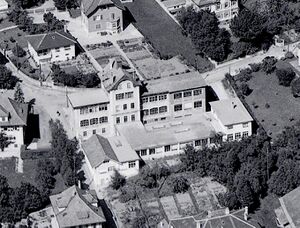
A new company named Nouvelle Fabrique de Tavannes SA was registered on April 27, 1932. Capitalized at just 12,00 francs, the company aimed to re-start production in the now-old "New Factory" building. It was administrated by Georges Droz of Mont-Tramelan and Edouard Haenni of Reichenbach. Droz and Haenni were replaced as administrators by technical director Maurice Eberlé of Le Locle on June 22, 1933. The company dropped the word "Tavannes" and was renamed "Nouvelle Fabrique SA" on December 13, 1934. Next, on December 22, 1937, the company was re-capitalized at 15,000 francs.

The factory struggled through the 1930s. Like many other companies, the factory came under the control of Ebauches SA on June 24, 1941, with share capital increased to 100,000 francs. The cartel re-focused the factory on "manufacture and sale of ebauches, watch supplies, and small mechanical items." at the same time as Derby in La Chaux-de-Fonds.
Still called "Nouvelle Fabrique", the factory in Tavannes remained a production site for Ebauches SA for decades under the management of Eberlé. Ebauches SA exercised tighter control, installing Sydney de Coulon as president and adding Henri Jeannot to the board in 1957, but Eberlé remained director and vice president. He was promoted to managing director in 1960, with Henri Sala added as director and successor.
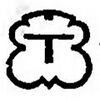
Following the death of Maurice Eberlé, the Nouvelle Fabrique was decommissioned. The company officially removed de Coulon and Jeannot from management on December 20, 1966 and was taken over by the larger Tavannes Watch company. Léo DuPasquier, Walter Bannwart, Raymond Baumann, Pierre-Louis Sulliger, and Charles-Martin-Louis Mombelli took over the assets of the company.
The combined company was called Ebauches Tavannes, and continued in operation into the 1970s. It joined the Fabriques d'Ebauches Réunies in the 1970s and became a quartz movement assembly specialist. A production line of analog quartz movements was set up in November 1977, supplying FHF, another member of Ebauches SA but oddly not a member of FER. Ebauches Tavannes was merged with the other components of Ebauches SA and was finally deleted from the commercial register in 1979.
Later Use of the Building
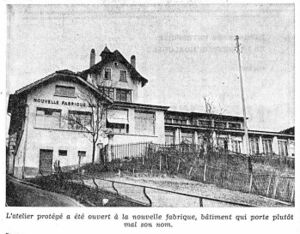
The Nouvelle Fabrique building remained vacant for a few years before being purchased by the Canton in 1968 to become a workshop for patients of the psychiatric clinic of Bellelay. The residents of Tavannes opposed housing the patients on site, though the workshop operated through the 1970s.
The original factory building was demolished in 1987, leaving only the low, flat-roofed 1917 L-shaped workshop, which remains to this day.